Egypt's Health Sector: Overview, Vision, and Key Indicators
VerifiedAdded on 2021/09/10
|14
|5840
|50
Report
AI Summary
This report provides a comprehensive overview of the health sector in Egypt, examining its current state, challenges, and strategic vision for the future. It analyzes the health situation at three levels: public health indicators, healthcare accessibility and quality, and health sector management. The report highlights key issues such as high Hepatitis C incidence and the need for improved healthcare expenditure. It outlines the strategic vision for 2030, focusing on improved citizen health, universal healthcare coverage, and improved health sector governance. Key performance indicators are presented to monitor progress, including life expectancy, maternal and child mortality rates, and per capita health expenditure. The report emphasizes the need for a holistic approach involving multiple sectors and stakeholders to achieve the health goals.
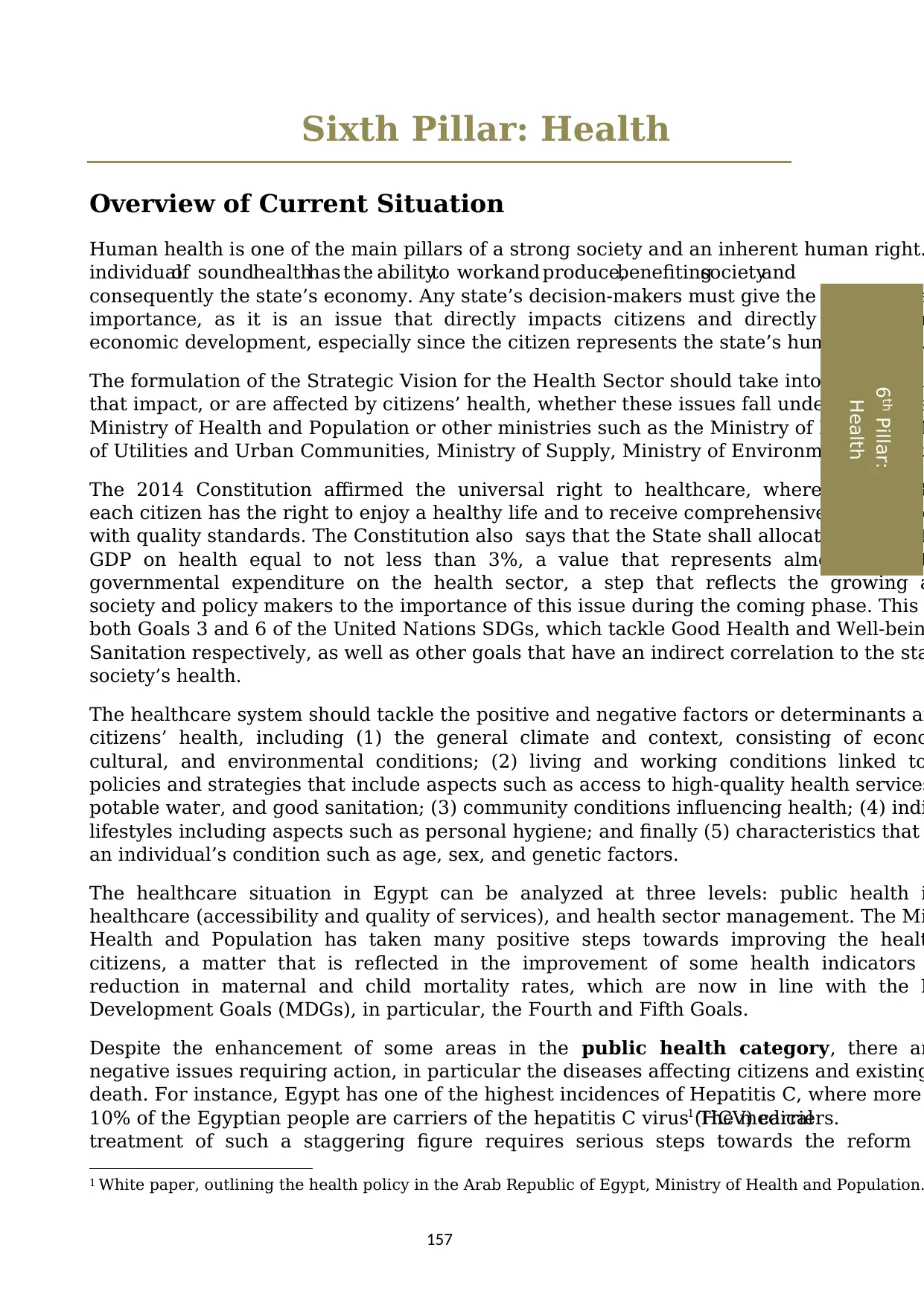
157
Sixth Pillar: Health
Overview of Current Situation
Human health is one of the main pillars of a strong society and an inherent human right.
individualof soundhealthhas the abilityto work and produce,benefitingsocietyand
consequently the state’s economy. Any state’s decision-makers must give the health pilla
importance, as it is an issue that directly impacts citizens and directly affects hu
economic development, especially since the citizen represents the state’s human capital.
The formulation of the Strategic Vision for the Health Sector should take into account al
that impact, or are affected by citizens’ health, whether these issues fall under the scope
Ministry of Health and Population or other ministries such as the Ministry of Housing, M
of Utilities and Urban Communities, Ministry of Supply, Ministry of Environment, and ot
The 2014 Constitution affirmed the universal right to healthcare, where Article 18
each citizen has the right to enjoy a healthy life and to receive comprehensive healthcare
with quality standards. The Constitution also says that the State shall allocate a percent
GDP on health equal to not less than 3%, a value that represents almost twice t
governmental expenditure on the health sector, a step that reflects the growing a
society and policy makers to the importance of this issue during the coming phase. This
both Goals 3 and 6 of the United Nations SDGs, which tackle Good Health and Well-bein
Sanitation respectively, as well as other goals that have an indirect correlation to the sta
society’s health.
The healthcare system should tackle the positive and negative factors or determinants aff
citizens’ health, including (1) the general climate and context, consisting of econo
cultural, and environmental conditions; (2) living and working conditions linked to
policies and strategies that include aspects such as access to high-quality health services
potable water, and good sanitation; (3) community conditions influencing health; (4) indi
lifestyles including aspects such as personal hygiene; and finally (5) characteristics that
an individual’s condition such as age, sex, and genetic factors.
The healthcare situation in Egypt can be analyzed at three levels: public health i
healthcare (accessibility and quality of services), and health sector management. The Mi
Health and Population has taken many positive steps towards improving the healt
citizens, a matter that is reflected in the improvement of some health indicators
reduction in maternal and child mortality rates, which are now in line with the M
Development Goals (MDGs), in particular, the Fourth and Fifth Goals.
Despite the enhancement of some areas in the public health category, there ar
negative issues requiring action, in particular the diseases affecting citizens and existing
death. For instance, Egypt has one of the highest incidences of Hepatitis C, where more
10% of the Egyptian people are carriers of the hepatitis C virus (HCV) carriers.1 The medical
treatment of such a staggering figure requires serious steps towards the reform o
1 White paper, outlining the health policy in the Arab Republic of Egypt, Ministry of Health and Population.
6th Pillar:
Health
Sixth Pillar: Health
Overview of Current Situation
Human health is one of the main pillars of a strong society and an inherent human right.
individualof soundhealthhas the abilityto work and produce,benefitingsocietyand
consequently the state’s economy. Any state’s decision-makers must give the health pilla
importance, as it is an issue that directly impacts citizens and directly affects hu
economic development, especially since the citizen represents the state’s human capital.
The formulation of the Strategic Vision for the Health Sector should take into account al
that impact, or are affected by citizens’ health, whether these issues fall under the scope
Ministry of Health and Population or other ministries such as the Ministry of Housing, M
of Utilities and Urban Communities, Ministry of Supply, Ministry of Environment, and ot
The 2014 Constitution affirmed the universal right to healthcare, where Article 18
each citizen has the right to enjoy a healthy life and to receive comprehensive healthcare
with quality standards. The Constitution also says that the State shall allocate a percent
GDP on health equal to not less than 3%, a value that represents almost twice t
governmental expenditure on the health sector, a step that reflects the growing a
society and policy makers to the importance of this issue during the coming phase. This
both Goals 3 and 6 of the United Nations SDGs, which tackle Good Health and Well-bein
Sanitation respectively, as well as other goals that have an indirect correlation to the sta
society’s health.
The healthcare system should tackle the positive and negative factors or determinants aff
citizens’ health, including (1) the general climate and context, consisting of econo
cultural, and environmental conditions; (2) living and working conditions linked to
policies and strategies that include aspects such as access to high-quality health services
potable water, and good sanitation; (3) community conditions influencing health; (4) indi
lifestyles including aspects such as personal hygiene; and finally (5) characteristics that
an individual’s condition such as age, sex, and genetic factors.
The healthcare situation in Egypt can be analyzed at three levels: public health i
healthcare (accessibility and quality of services), and health sector management. The Mi
Health and Population has taken many positive steps towards improving the healt
citizens, a matter that is reflected in the improvement of some health indicators
reduction in maternal and child mortality rates, which are now in line with the M
Development Goals (MDGs), in particular, the Fourth and Fifth Goals.
Despite the enhancement of some areas in the public health category, there ar
negative issues requiring action, in particular the diseases affecting citizens and existing
death. For instance, Egypt has one of the highest incidences of Hepatitis C, where more
10% of the Egyptian people are carriers of the hepatitis C virus (HCV) carriers.1 The medical
treatment of such a staggering figure requires serious steps towards the reform o
1 White paper, outlining the health policy in the Arab Republic of Egypt, Ministry of Health and Population.
6th Pillar:
Health
Paraphrase This Document
Need a fresh take? Get an instant paraphrase of this document with our AI Paraphraser
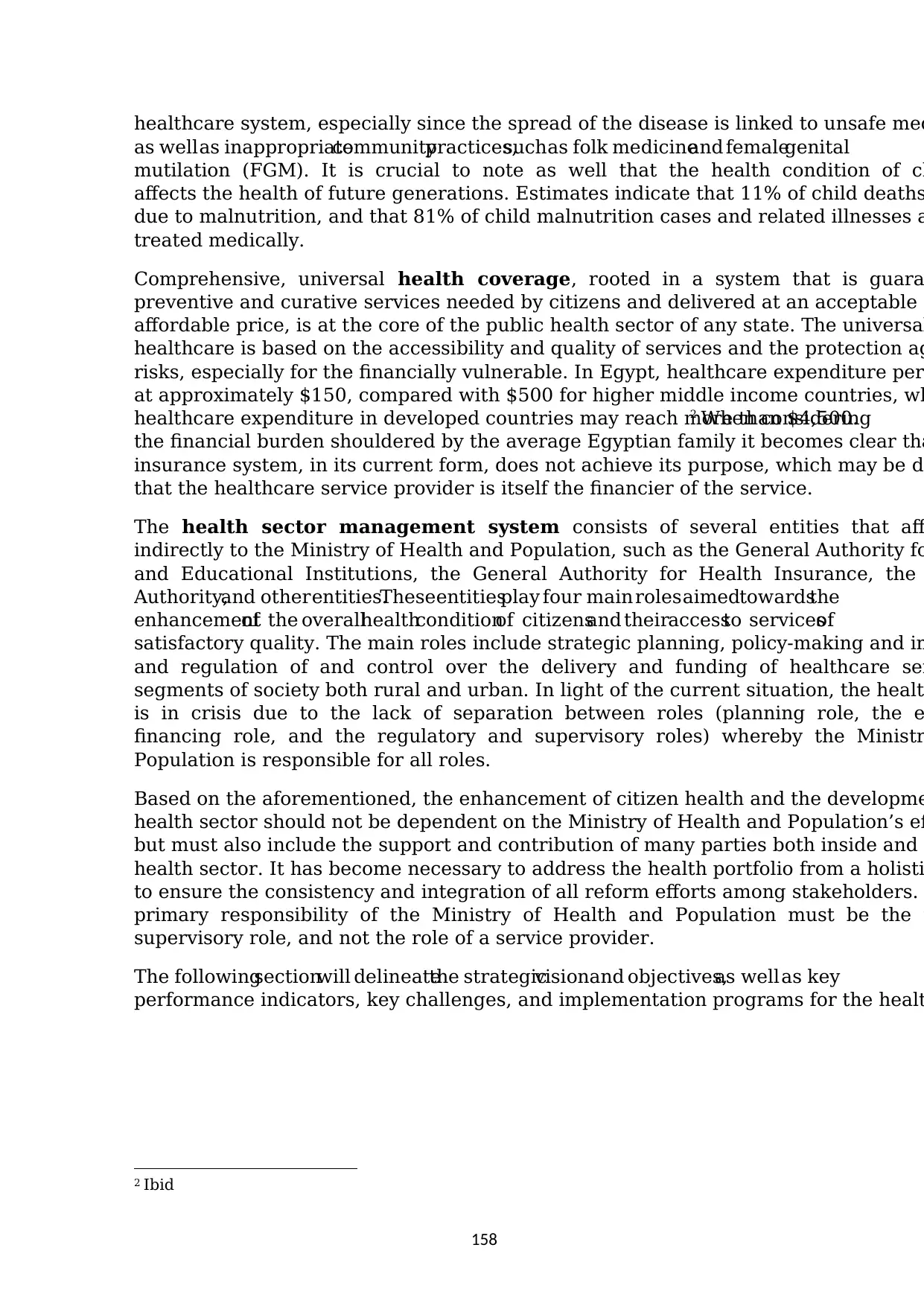
158
healthcare system, especially since the spread of the disease is linked to unsafe med
as well as inappropriatecommunitypractices,suchas folk medicineand femalegenital
mutilation (FGM). It is crucial to note as well that the health condition of ch
affects the health of future generations. Estimates indicate that 11% of child deaths
due to malnutrition, and that 81% of child malnutrition cases and related illnesses a
treated medically.
Comprehensive, universal health coverage, rooted in a system that is guara
preventive and curative services needed by citizens and delivered at an acceptable q
affordable price, is at the core of the public health sector of any state. The universal
healthcare is based on the accessibility and quality of services and the protection ag
risks, especially for the financially vulnerable. In Egypt, healthcare expenditure per
at approximately $150, compared with $500 for higher middle income countries, wh
healthcare expenditure in developed countries may reach more than $4,500.2 When considering
the financial burden shouldered by the average Egyptian family it becomes clear tha
insurance system, in its current form, does not achieve its purpose, which may be d
that the healthcare service provider is itself the financier of the service.
The health sector management system consists of several entities that aff
indirectly to the Ministry of Health and Population, such as the General Authority fo
and Educational Institutions, the General Authority for Health Insurance, the
Authority,and other entities.Theseentitiesplay four main roles aimedtowardsthe
enhancementof the overallhealthconditionof citizensand theiraccessto servicesof
satisfactory quality. The main roles include strategic planning, policy-making and im
and regulation of and control over the delivery and funding of healthcare ser
segments of society both rural and urban. In light of the current situation, the healt
is in crisis due to the lack of separation between roles (planning role, the e
financing role, and the regulatory and supervisory roles) whereby the Ministr
Population is responsible for all roles.
Based on the aforementioned, the enhancement of citizen health and the developme
health sector should not be dependent on the Ministry of Health and Population’s eff
but must also include the support and contribution of many parties both inside and
health sector. It has become necessary to address the health portfolio from a holisti
to ensure the consistency and integration of all reform efforts among stakeholders.
primary responsibility of the Ministry of Health and Population must be the r
supervisory role, and not the role of a service provider.
The followingsectionwill delineatethe strategicvisionand objectives,as well as key
performance indicators, key challenges, and implementation programs for the healt
2 Ibid
healthcare system, especially since the spread of the disease is linked to unsafe med
as well as inappropriatecommunitypractices,suchas folk medicineand femalegenital
mutilation (FGM). It is crucial to note as well that the health condition of ch
affects the health of future generations. Estimates indicate that 11% of child deaths
due to malnutrition, and that 81% of child malnutrition cases and related illnesses a
treated medically.
Comprehensive, universal health coverage, rooted in a system that is guara
preventive and curative services needed by citizens and delivered at an acceptable q
affordable price, is at the core of the public health sector of any state. The universal
healthcare is based on the accessibility and quality of services and the protection ag
risks, especially for the financially vulnerable. In Egypt, healthcare expenditure per
at approximately $150, compared with $500 for higher middle income countries, wh
healthcare expenditure in developed countries may reach more than $4,500.2 When considering
the financial burden shouldered by the average Egyptian family it becomes clear tha
insurance system, in its current form, does not achieve its purpose, which may be d
that the healthcare service provider is itself the financier of the service.
The health sector management system consists of several entities that aff
indirectly to the Ministry of Health and Population, such as the General Authority fo
and Educational Institutions, the General Authority for Health Insurance, the
Authority,and other entities.Theseentitiesplay four main roles aimedtowardsthe
enhancementof the overallhealthconditionof citizensand theiraccessto servicesof
satisfactory quality. The main roles include strategic planning, policy-making and im
and regulation of and control over the delivery and funding of healthcare ser
segments of society both rural and urban. In light of the current situation, the healt
is in crisis due to the lack of separation between roles (planning role, the e
financing role, and the regulatory and supervisory roles) whereby the Ministr
Population is responsible for all roles.
Based on the aforementioned, the enhancement of citizen health and the developme
health sector should not be dependent on the Ministry of Health and Population’s eff
but must also include the support and contribution of many parties both inside and
health sector. It has become necessary to address the health portfolio from a holisti
to ensure the consistency and integration of all reform efforts among stakeholders.
primary responsibility of the Ministry of Health and Population must be the r
supervisory role, and not the role of a service provider.
The followingsectionwill delineatethe strategicvisionand objectives,as well as key
performance indicators, key challenges, and implementation programs for the healt
2 Ibid
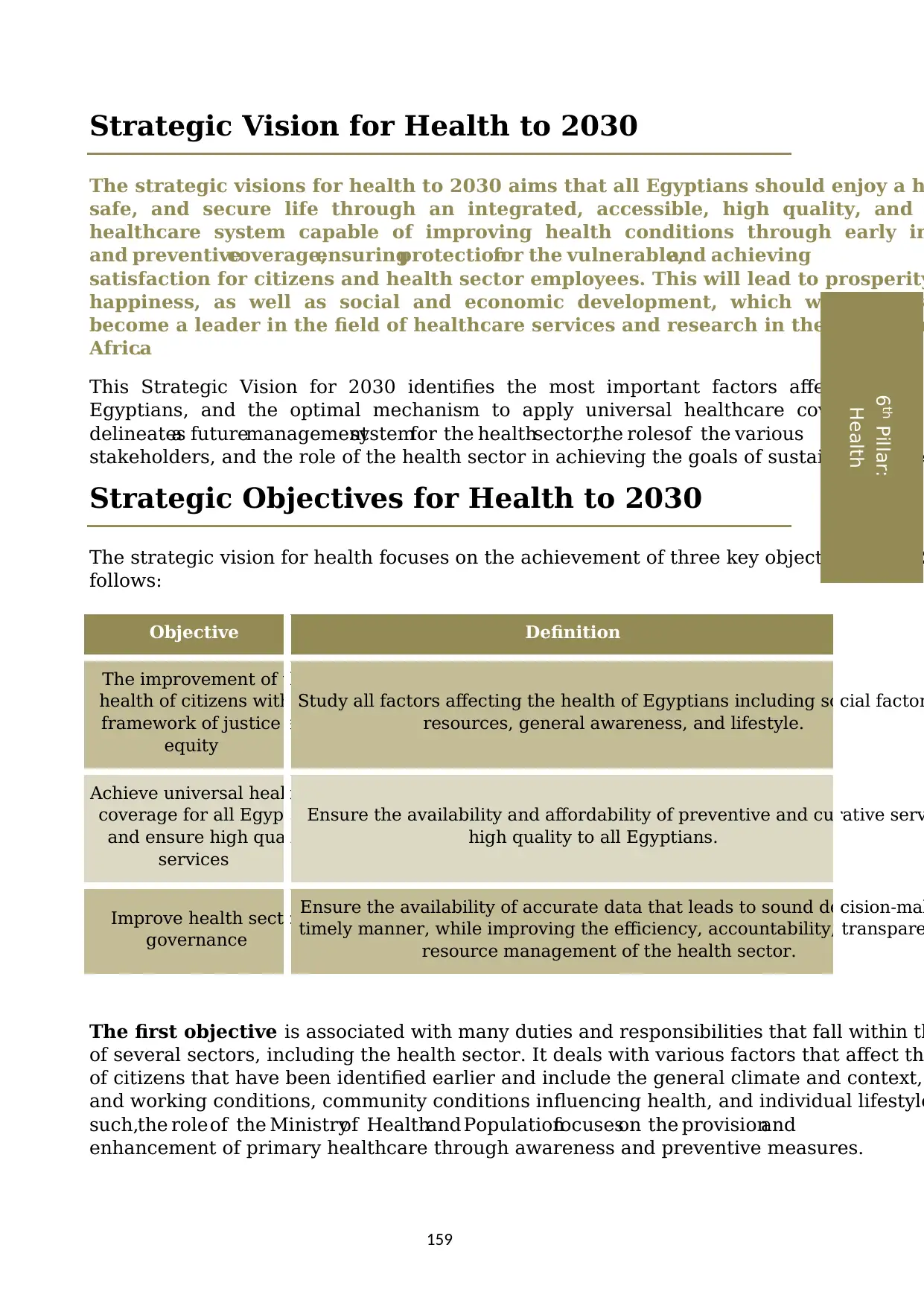
159
Strategic Vision for Health to 2030
The strategic visions for health to 2030 aims that all Egyptians should enjoy a h
safe, and secure life through an integrated, accessible, high quality, and
healthcare system capable of improving health conditions through early in
and preventivecoverage,ensuringprotectionfor the vulnerable,and achieving
satisfaction for citizens and health sector employees. This will lead to prosperity
happiness, as well as social and economic development, which will qualify
become a leader in the field of healthcare services and research in the Arab Wor
Africa.
This Strategic Vision for 2030 identifies the most important factors affecting the
Egyptians, and the optimal mechanism to apply universal healthcare coverage for
delineatesa futuremanagementsystemfor the healthsector,the rolesof the various
stakeholders, and the role of the health sector in achieving the goals of sustainable deve
Strategic Objectives for Health to 2030
The strategic vision for health focuses on the achievement of three key objectives until 2
follows:
Objective Definition
The improvement of the
health of citizens within a
framework of justice and
equity
Study all factors affecting the health of Egyptians including social factor
resources, general awareness, and lifestyle.
Achieve universal healthcare
coverage for all Egyptians
and ensure high quality
services
Ensure the availability and affordability of preventive and curative serv
high quality to all Egyptians.
Improve health sector
governance
Ensure the availability of accurate data that leads to sound decision-mak
timely manner, while improving the efficiency, accountability, transpare
resource management of the health sector.
The first objective is associated with many duties and responsibilities that fall within th
of several sectors, including the health sector. It deals with various factors that affect th
of citizens that have been identified earlier and include the general climate and context,
and working conditions, community conditions influencing health, and individual lifestyle
such,the role of the Ministryof Healthand Populationfocuseson the provisionand
enhancement of primary healthcare through awareness and preventive measures.
6th Pillar:
Health
Strategic Vision for Health to 2030
The strategic visions for health to 2030 aims that all Egyptians should enjoy a h
safe, and secure life through an integrated, accessible, high quality, and
healthcare system capable of improving health conditions through early in
and preventivecoverage,ensuringprotectionfor the vulnerable,and achieving
satisfaction for citizens and health sector employees. This will lead to prosperity
happiness, as well as social and economic development, which will qualify
become a leader in the field of healthcare services and research in the Arab Wor
Africa.
This Strategic Vision for 2030 identifies the most important factors affecting the
Egyptians, and the optimal mechanism to apply universal healthcare coverage for
delineatesa futuremanagementsystemfor the healthsector,the rolesof the various
stakeholders, and the role of the health sector in achieving the goals of sustainable deve
Strategic Objectives for Health to 2030
The strategic vision for health focuses on the achievement of three key objectives until 2
follows:
Objective Definition
The improvement of the
health of citizens within a
framework of justice and
equity
Study all factors affecting the health of Egyptians including social factor
resources, general awareness, and lifestyle.
Achieve universal healthcare
coverage for all Egyptians
and ensure high quality
services
Ensure the availability and affordability of preventive and curative serv
high quality to all Egyptians.
Improve health sector
governance
Ensure the availability of accurate data that leads to sound decision-mak
timely manner, while improving the efficiency, accountability, transpare
resource management of the health sector.
The first objective is associated with many duties and responsibilities that fall within th
of several sectors, including the health sector. It deals with various factors that affect th
of citizens that have been identified earlier and include the general climate and context,
and working conditions, community conditions influencing health, and individual lifestyle
such,the role of the Ministryof Healthand Populationfocuseson the provisionand
enhancement of primary healthcare through awareness and preventive measures.
6th Pillar:
Health
⊘ This is a preview!⊘
Do you want full access?
Subscribe today to unlock all pages.

Trusted by 1+ million students worldwide
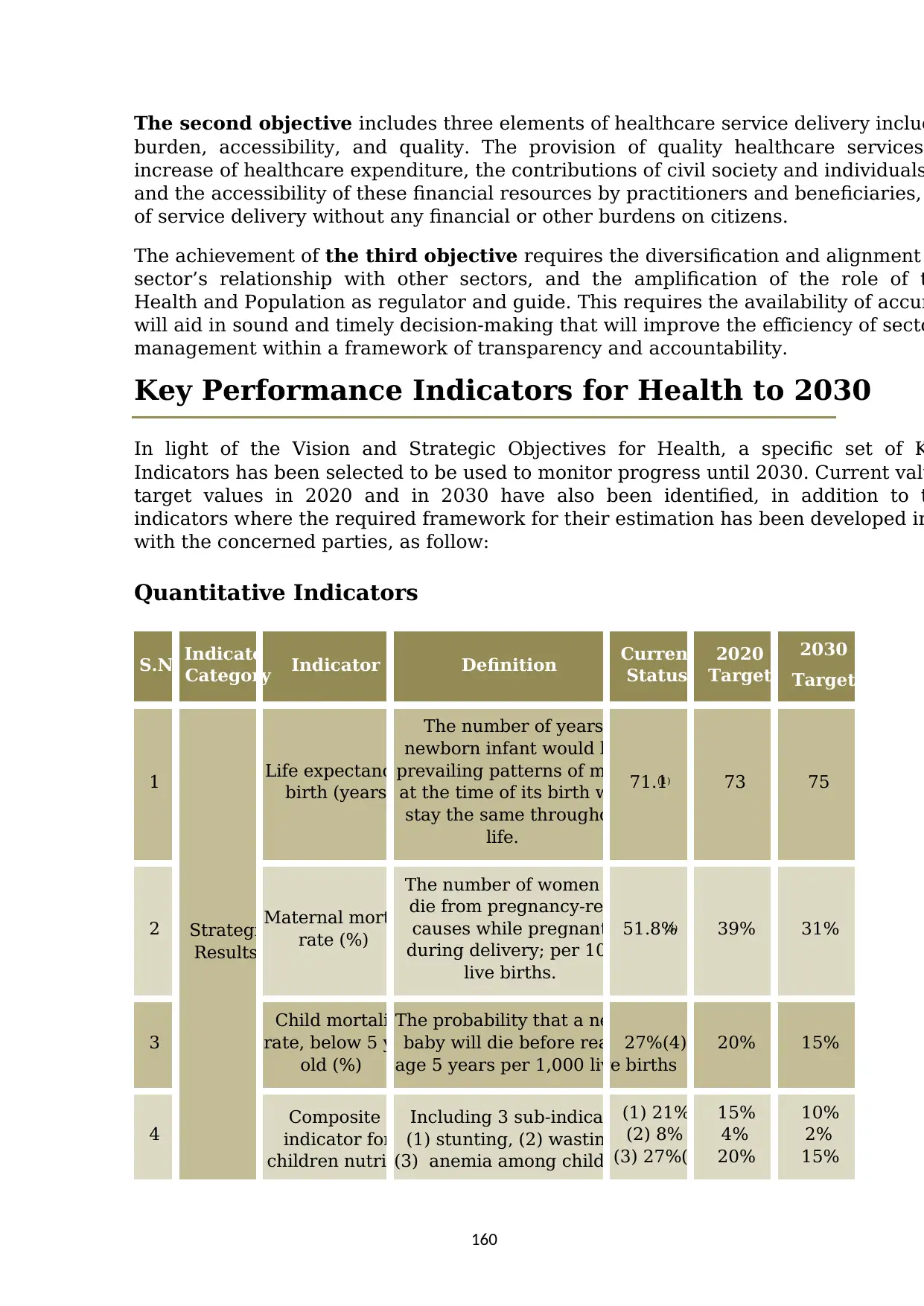
160
The second objective includes three elements of healthcare service delivery includ
burden, accessibility, and quality. The provision of quality healthcare services
increase of healthcare expenditure, the contributions of civil society and individuals
and the accessibility of these financial resources by practitioners and beneficiaries,
of service delivery without any financial or other burdens on citizens.
The achievement of the third objective requires the diversification and alignment
sector’s relationship with other sectors, and the amplification of the role of t
Health and Population as regulator and guide. This requires the availability of accur
will aid in sound and timely decision-making that will improve the efficiency of secto
management within a framework of transparency and accountability.
Key Performance Indicators for Health to 2030
In light of the Vision and Strategic Objectives for Health, a specific set of K
Indicators has been selected to be used to monitor progress until 2030. Current valu
target values in 2020 and in 2030 have also been identified, in addition to t
indicators where the required framework for their estimation has been developed in
with the concerned parties, as follow:
Quantitative Indicators
S.N Indicator
Category Indicator Definition Current
Status
2020
Target
2030
Target
1
Strategic
Results
Life expectancy at
birth (years)
The number of years a
newborn infant would live if
prevailing patterns of mortality
at the time of its birth were to
stay the same throughout its
life.
71.1(1) 73 75
2 Maternal mortality
rate (%)
The number of women who
die from pregnancy-related
causes while pregnant and
during delivery; per 100,000
live births.
51.8%(3) 39% 31%
3
Child mortality
rate, below 5 years
old (%)
The probability that a newborn
baby will die before reaching
age 5 years per 1,000 live births
27%(4) 20% 15%
4
Composite
indicator for
children nutrition
Including 3 sub-indicators:
(1) stunting, (2) wasting and
(3) anemia among children less
(1) 21%
(2) 8%
(3) 27%(3)
15%
4%
20%
10%
2%
15%
The second objective includes three elements of healthcare service delivery includ
burden, accessibility, and quality. The provision of quality healthcare services
increase of healthcare expenditure, the contributions of civil society and individuals
and the accessibility of these financial resources by practitioners and beneficiaries,
of service delivery without any financial or other burdens on citizens.
The achievement of the third objective requires the diversification and alignment
sector’s relationship with other sectors, and the amplification of the role of t
Health and Population as regulator and guide. This requires the availability of accur
will aid in sound and timely decision-making that will improve the efficiency of secto
management within a framework of transparency and accountability.
Key Performance Indicators for Health to 2030
In light of the Vision and Strategic Objectives for Health, a specific set of K
Indicators has been selected to be used to monitor progress until 2030. Current valu
target values in 2020 and in 2030 have also been identified, in addition to t
indicators where the required framework for their estimation has been developed in
with the concerned parties, as follow:
Quantitative Indicators
S.N Indicator
Category Indicator Definition Current
Status
2020
Target
2030
Target
1
Strategic
Results
Life expectancy at
birth (years)
The number of years a
newborn infant would live if
prevailing patterns of mortality
at the time of its birth were to
stay the same throughout its
life.
71.1(1) 73 75
2 Maternal mortality
rate (%)
The number of women who
die from pregnancy-related
causes while pregnant and
during delivery; per 100,000
live births.
51.8%(3) 39% 31%
3
Child mortality
rate, below 5 years
old (%)
The probability that a newborn
baby will die before reaching
age 5 years per 1,000 live births
27%(4) 20% 15%
4
Composite
indicator for
children nutrition
Including 3 sub-indicators:
(1) stunting, (2) wasting and
(3) anemia among children less
(1) 21%
(2) 8%
(3) 27%(3)
15%
4%
20%
10%
2%
15%
Paraphrase This Document
Need a fresh take? Get an instant paraphrase of this document with our AI Paraphraser
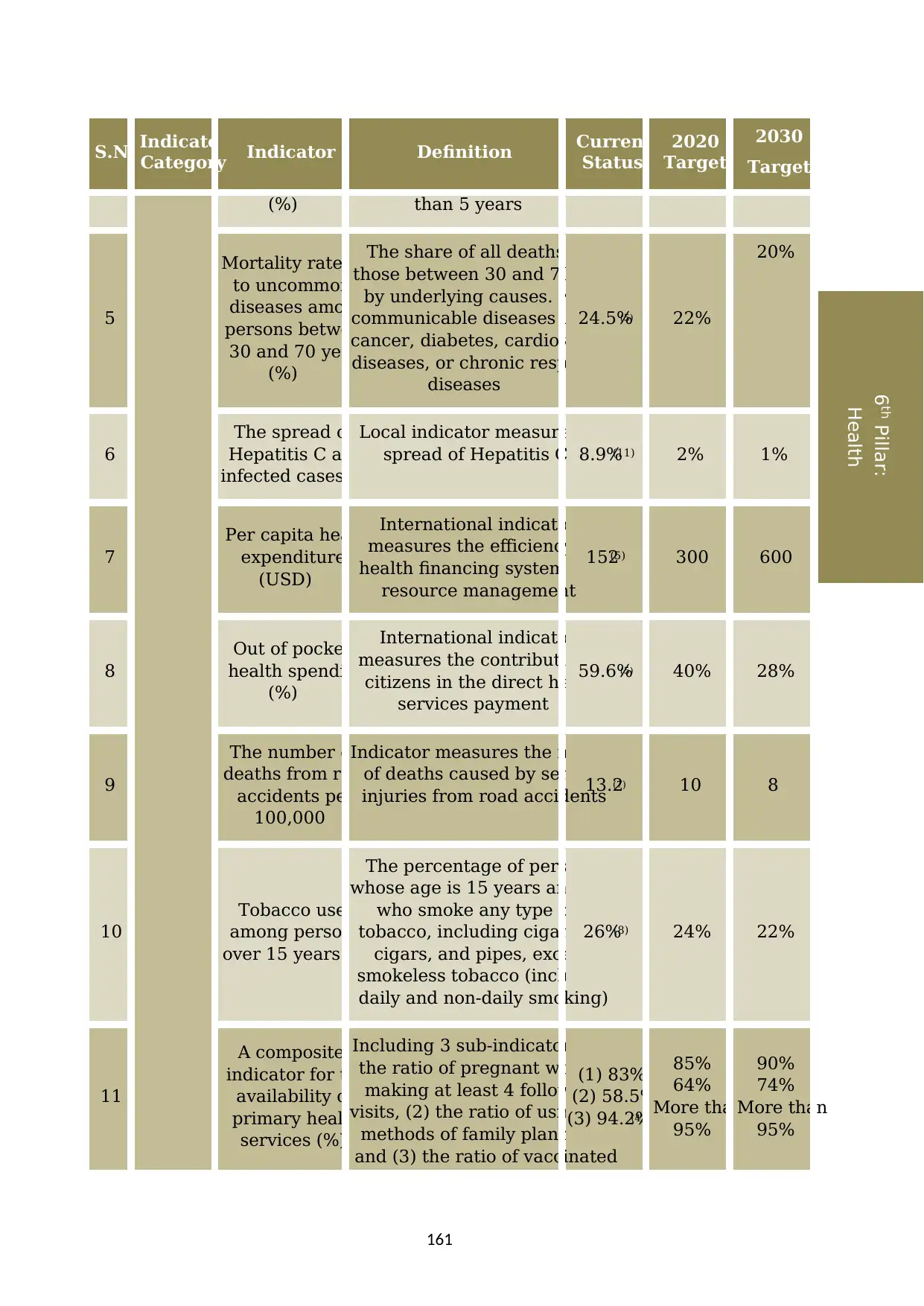
161
S.N Indicator
Category Indicator Definition Current
Status
2020
Target
2030
Target
(%) than 5 years
5
Mortality rate due
to uncommon
diseases among
persons between
30 and 70 years
(%)
The share of all deaths for
those between 30 and 70 years
by underlying causes. Non-
communicable diseases include
cancer, diabetes, cardiovascular
diseases, or chronic respiratory
diseases
24.5%(5) 22%
20%
6
The spread of
Hepatitis C and
infected cases (%)
Local indicator measures the
spread of Hepatitis C 8.9%(11) 2% 1%
7
Per capita health
expenditure
(USD)
International indicator
measures the efficiency of
health financing systems and
resource management
152(5) 300 600
8
Out of pocket
health spending
(%)
International indicator
measures the contribution of
citizens in the direct health
services payment
59.6%(5) 40% 28%
9
The number of
deaths from road
accidents per
100,000
Indicator measures the number
of deaths caused by serious
injuries from road accidents
13.2(7) 10 8
10
Tobacco use
among persons
over 15 years (%)
The percentage of persons
whose age is 15 years and more
who smoke any type of
tobacco, including cigarettes,
cigars, and pipes, except
smokeless tobacco (including
daily and non-daily smoking)
26%(8) 24% 22%
11
A composite
indicator for the
availability of
primary health
services (%)
Including 3 sub-indicators: (1)
the ratio of pregnant women
making at least 4 follow up
visits, (2) the ratio of using new
methods of family planning,
and (3) the ratio of vaccinated
(1) 83%
(2) 58.5%
(3) 94.2%(4)
85%
64%
More than
95%
90%
74%
More than
95%
6th Pillar:
Health
S.N Indicator
Category Indicator Definition Current
Status
2020
Target
2030
Target
(%) than 5 years
5
Mortality rate due
to uncommon
diseases among
persons between
30 and 70 years
(%)
The share of all deaths for
those between 30 and 70 years
by underlying causes. Non-
communicable diseases include
cancer, diabetes, cardiovascular
diseases, or chronic respiratory
diseases
24.5%(5) 22%
20%
6
The spread of
Hepatitis C and
infected cases (%)
Local indicator measures the
spread of Hepatitis C 8.9%(11) 2% 1%
7
Per capita health
expenditure
(USD)
International indicator
measures the efficiency of
health financing systems and
resource management
152(5) 300 600
8
Out of pocket
health spending
(%)
International indicator
measures the contribution of
citizens in the direct health
services payment
59.6%(5) 40% 28%
9
The number of
deaths from road
accidents per
100,000
Indicator measures the number
of deaths caused by serious
injuries from road accidents
13.2(7) 10 8
10
Tobacco use
among persons
over 15 years (%)
The percentage of persons
whose age is 15 years and more
who smoke any type of
tobacco, including cigarettes,
cigars, and pipes, except
smokeless tobacco (including
daily and non-daily smoking)
26%(8) 24% 22%
11
A composite
indicator for the
availability of
primary health
services (%)
Including 3 sub-indicators: (1)
the ratio of pregnant women
making at least 4 follow up
visits, (2) the ratio of using new
methods of family planning,
and (3) the ratio of vaccinated
(1) 83%
(2) 58.5%
(3) 94.2%(4)
85%
64%
More than
95%
90%
74%
More than
95%
6th Pillar:
Health
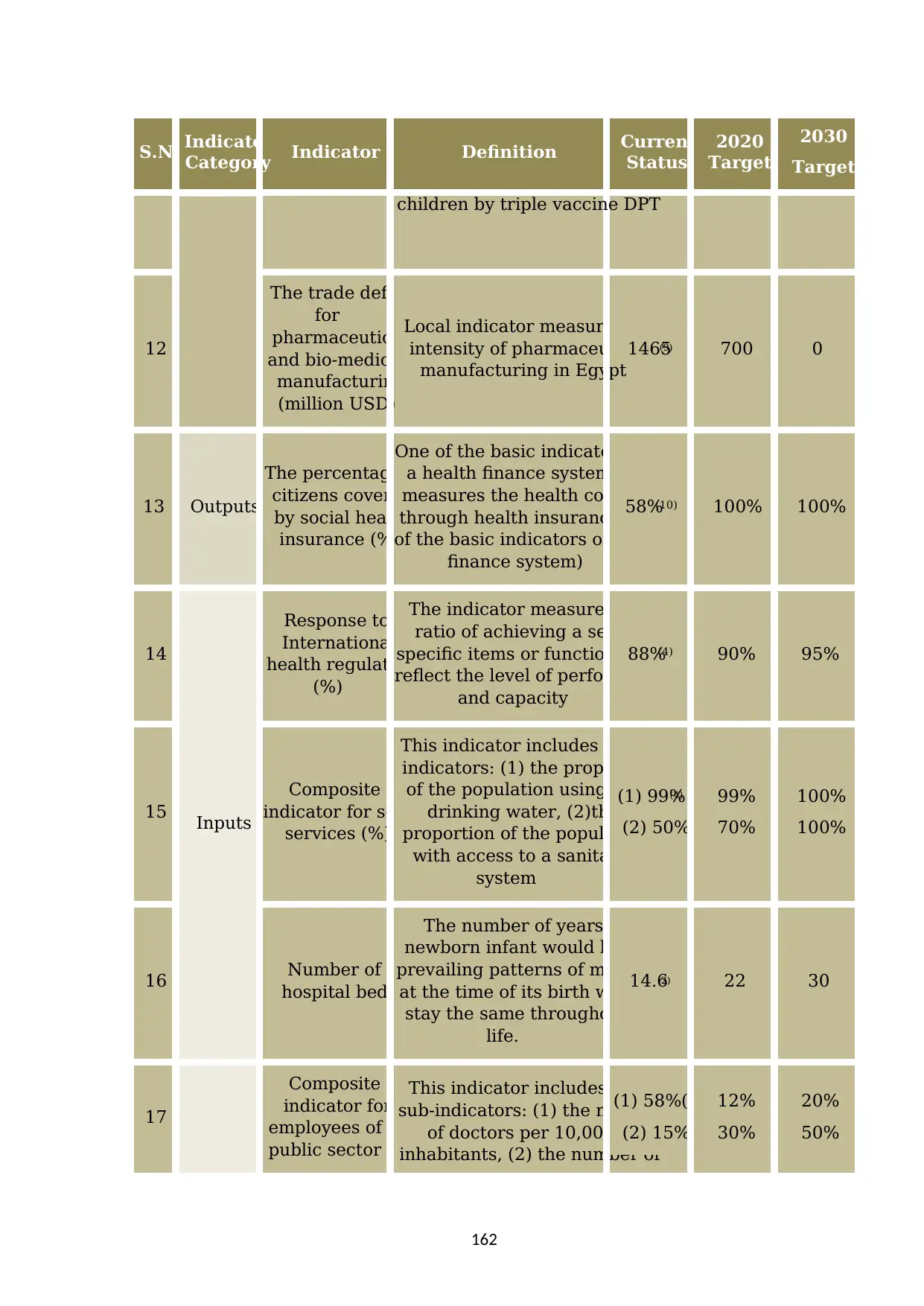
162
S.N Indicator
Category Indicator Definition Current
Status
2020
Target
2030
Target
children by triple vaccine DPT
12
The trade deficit
for
pharmaceuticals
and bio-medicine
manufacturing
(million USD)
Local indicator measures the
intensity of pharmaceutical
manufacturing in Egypt
1465(9) 700 0
13 Outputs
The percentage of
citizens covered
by social health
insurance (%)
One of the basic indicators for
a health finance system as it
measures the health coverage
through health insurance (one
of the basic indicators of health
finance system)
58%(10) 100% 100%
14
Inputs
Response to
International
health regulations
(%)
The indicator measures the
ratio of achieving a set of
specific items or functions that
reflect the level of performance
and capacity
88%(4) 90% 95%
15
Composite
indicator for social
services (%)
This indicator includes 2 sub-
indicators: (1) the proportion
of the population using safe
drinking water, (2)the
proportion of the population
with access to a sanitation
system
(1) 99%(4)
(2) 50%
99%
70%
100%
100%
16 Number of
hospital beds
The number of years a
newborn infant would live if
prevailing patterns of mortality
at the time of its birth were to
stay the same throughout its
life.
14.6(2) 22 30
17
Composite
indicator for
employees of the
public sector (%)
This indicator includes two
sub-indicators: (1) the number
of doctors per 10,000
inhabitants, (2) the number of
(1) 58%(2)
(2) 15%
12%
30%
20%
50%
S.N Indicator
Category Indicator Definition Current
Status
2020
Target
2030
Target
children by triple vaccine DPT
12
The trade deficit
for
pharmaceuticals
and bio-medicine
manufacturing
(million USD)
Local indicator measures the
intensity of pharmaceutical
manufacturing in Egypt
1465(9) 700 0
13 Outputs
The percentage of
citizens covered
by social health
insurance (%)
One of the basic indicators for
a health finance system as it
measures the health coverage
through health insurance (one
of the basic indicators of health
finance system)
58%(10) 100% 100%
14
Inputs
Response to
International
health regulations
(%)
The indicator measures the
ratio of achieving a set of
specific items or functions that
reflect the level of performance
and capacity
88%(4) 90% 95%
15
Composite
indicator for social
services (%)
This indicator includes 2 sub-
indicators: (1) the proportion
of the population using safe
drinking water, (2)the
proportion of the population
with access to a sanitation
system
(1) 99%(4)
(2) 50%
99%
70%
100%
100%
16 Number of
hospital beds
The number of years a
newborn infant would live if
prevailing patterns of mortality
at the time of its birth were to
stay the same throughout its
life.
14.6(2) 22 30
17
Composite
indicator for
employees of the
public sector (%)
This indicator includes two
sub-indicators: (1) the number
of doctors per 10,000
inhabitants, (2) the number of
(1) 58%(2)
(2) 15%
12%
30%
20%
50%
⊘ This is a preview!⊘
Do you want full access?
Subscribe today to unlock all pages.

Trusted by 1+ million students worldwide
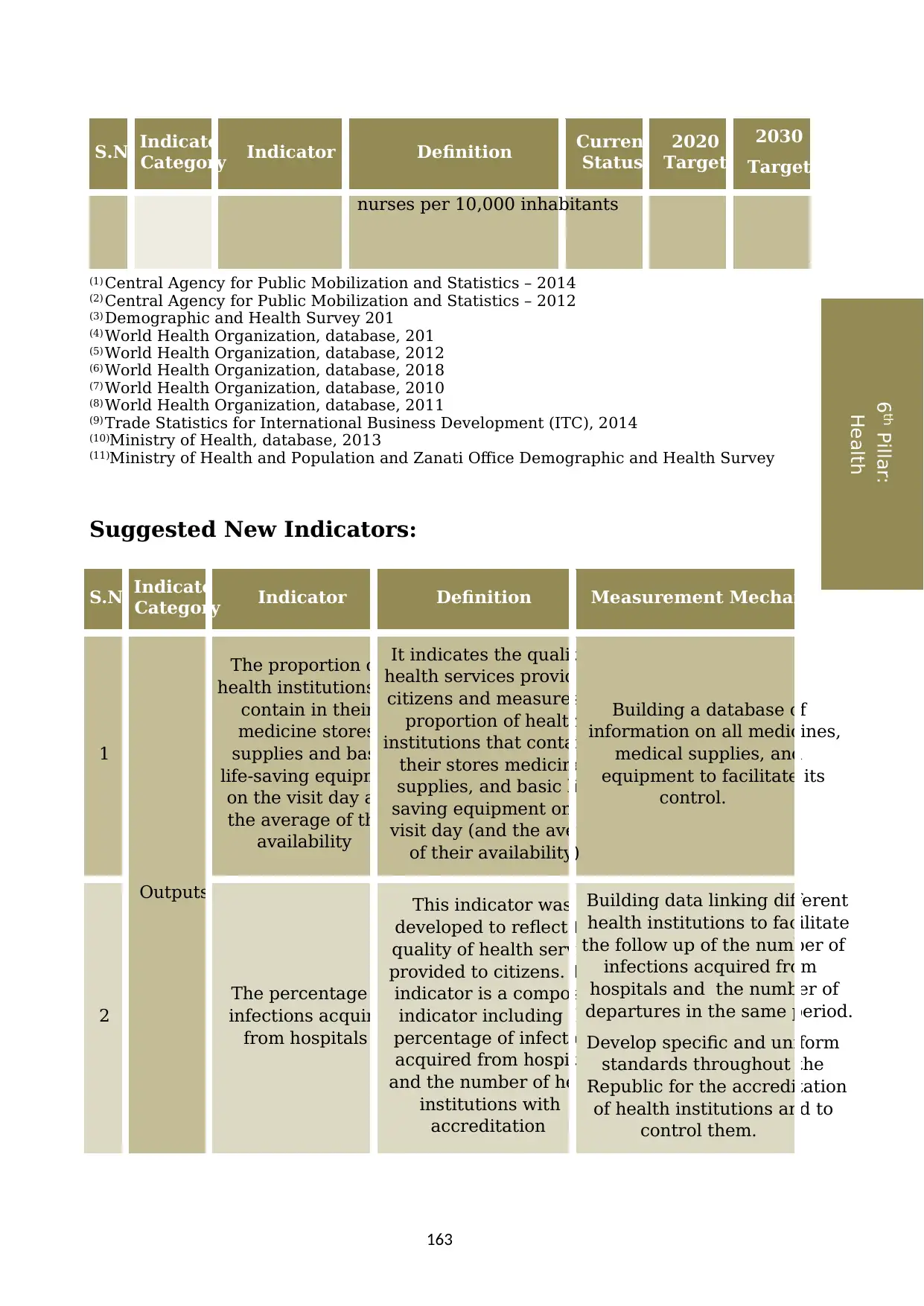
163
S.N Indicator
Category Indicator Definition Current
Status
2020
Target
2030
Target
nurses per 10,000 inhabitants
(1) Central Agency for Public Mobilization and Statistics – 2014
(2) Central Agency for Public Mobilization and Statistics – 2012
(3) Demographic and Health Survey 201
(4) World Health Organization, database, 201
(5) World Health Organization, database, 2012
(6) World Health Organization, database, 2018
(7) World Health Organization, database, 2010
(8) World Health Organization, database, 2011
(9) Trade Statistics for International Business Development (ITC), 2014
(10)Ministry of Health, database, 2013
(11)Ministry of Health and Population and Zanati Office Demographic and Health Survey
Suggested New Indicators:
S.N Indicator
Category Indicator Definition Measurement Mechanism
1
Outputs
The proportion of
health institutions that
contain in their
medicine stores,
supplies and basic
life-saving equipment
on the visit day and
the average of their
availability
It indicates the quality of
health services provided to
citizens and measures the
proportion of health
institutions that contains in
their stores medicines,
supplies, and basic life-
saving equipment on the
visit day (and the average
of their availability)
Building a database of
information on all medicines,
medical supplies, and
equipment to facilitate its
control.
2
The percentage of
infections acquired
from hospitals
This indicator was
developed to reflect the
quality of health services
provided to citizens. This
indicator is a composite
indicator including the
percentage of infections
acquired from hospitals
and the number of health
institutions with
accreditation
Building data linking different
health institutions to facilitate
the follow up of the number of
infections acquired from
hospitals and the number of
departures in the same period.
Develop specific and uniform
standards throughout the
Republic for the accreditation
of health institutions and to
control them.
6th Pillar:
Health
S.N Indicator
Category Indicator Definition Current
Status
2020
Target
2030
Target
nurses per 10,000 inhabitants
(1) Central Agency for Public Mobilization and Statistics – 2014
(2) Central Agency for Public Mobilization and Statistics – 2012
(3) Demographic and Health Survey 201
(4) World Health Organization, database, 201
(5) World Health Organization, database, 2012
(6) World Health Organization, database, 2018
(7) World Health Organization, database, 2010
(8) World Health Organization, database, 2011
(9) Trade Statistics for International Business Development (ITC), 2014
(10)Ministry of Health, database, 2013
(11)Ministry of Health and Population and Zanati Office Demographic and Health Survey
Suggested New Indicators:
S.N Indicator
Category Indicator Definition Measurement Mechanism
1
Outputs
The proportion of
health institutions that
contain in their
medicine stores,
supplies and basic
life-saving equipment
on the visit day and
the average of their
availability
It indicates the quality of
health services provided to
citizens and measures the
proportion of health
institutions that contains in
their stores medicines,
supplies, and basic life-
saving equipment on the
visit day (and the average
of their availability)
Building a database of
information on all medicines,
medical supplies, and
equipment to facilitate its
control.
2
The percentage of
infections acquired
from hospitals
This indicator was
developed to reflect the
quality of health services
provided to citizens. This
indicator is a composite
indicator including the
percentage of infections
acquired from hospitals
and the number of health
institutions with
accreditation
Building data linking different
health institutions to facilitate
the follow up of the number of
infections acquired from
hospitals and the number of
departures in the same period.
Develop specific and uniform
standards throughout the
Republic for the accreditation
of health institutions and to
control them.
6th Pillar:
Health
Paraphrase This Document
Need a fresh take? Get an instant paraphrase of this document with our AI Paraphraser

164
S.N Indicator
Category Indicator Definition Measurement Mechanism
3
The accurate
registration of births,
deaths, and causes of
death in the vital
registration reports
The accurate registration
of births, deaths, and
causes of death in the vital
registration reports to
make suitable decisions at
the right time
Automation of the registration
of births and deaths and
developing a system to review
the data and update the
regulations to ensure accurate
recording by facilities.
Challenges for the Health Sector
The challenges are divided into three main groups.
The first group of challenges is characterized by its significant impact and
control, and therefore shall take greater precedence. These challenges include the f
The poor state of the health insurance system and lack of compatibility
needs. Despite the large number of health insurance service subscribers, mos
the services of private sector providers or teaching hospitals.
The poor implementation of the Family Medicine system, which suffers
quality and medical staff shortages, despite the large number of health units a
country.
The absence of a health referral system from one service level to the next, wh
great pressure on central tertiary service providers such as the National Hear
and the National Oncology Institute.3
Mismatch between the financial resources available to the health sector and i
standards and local requirements, which reduces the quality and availability o
health programs and services, in addition to the poor efficiency and eff
employees in the health sector.
Lack of awareness of the importance of public health and proper nutrition, wh
citizens are ignorant of the importance of maintaining their health and followi
nutrition regimen, in addition to the lack of healthy lifestyle practices s
which leads to an overall degradation of citizens’ health.
Lack of coordination between the service provider and financier, given that th
and the same, leading to the existence of a conflict of interest, an inefficient g
system, lack of data accuracy, as well as poor service delivery.
3 Health Referral System
S.N Indicator
Category Indicator Definition Measurement Mechanism
3
The accurate
registration of births,
deaths, and causes of
death in the vital
registration reports
The accurate registration
of births, deaths, and
causes of death in the vital
registration reports to
make suitable decisions at
the right time
Automation of the registration
of births and deaths and
developing a system to review
the data and update the
regulations to ensure accurate
recording by facilities.
Challenges for the Health Sector
The challenges are divided into three main groups.
The first group of challenges is characterized by its significant impact and
control, and therefore shall take greater precedence. These challenges include the f
The poor state of the health insurance system and lack of compatibility
needs. Despite the large number of health insurance service subscribers, mos
the services of private sector providers or teaching hospitals.
The poor implementation of the Family Medicine system, which suffers
quality and medical staff shortages, despite the large number of health units a
country.
The absence of a health referral system from one service level to the next, wh
great pressure on central tertiary service providers such as the National Hear
and the National Oncology Institute.3
Mismatch between the financial resources available to the health sector and i
standards and local requirements, which reduces the quality and availability o
health programs and services, in addition to the poor efficiency and eff
employees in the health sector.
Lack of awareness of the importance of public health and proper nutrition, wh
citizens are ignorant of the importance of maintaining their health and followi
nutrition regimen, in addition to the lack of healthy lifestyle practices s
which leads to an overall degradation of citizens’ health.
Lack of coordination between the service provider and financier, given that th
and the same, leading to the existence of a conflict of interest, an inefficient g
system, lack of data accuracy, as well as poor service delivery.
3 Health Referral System
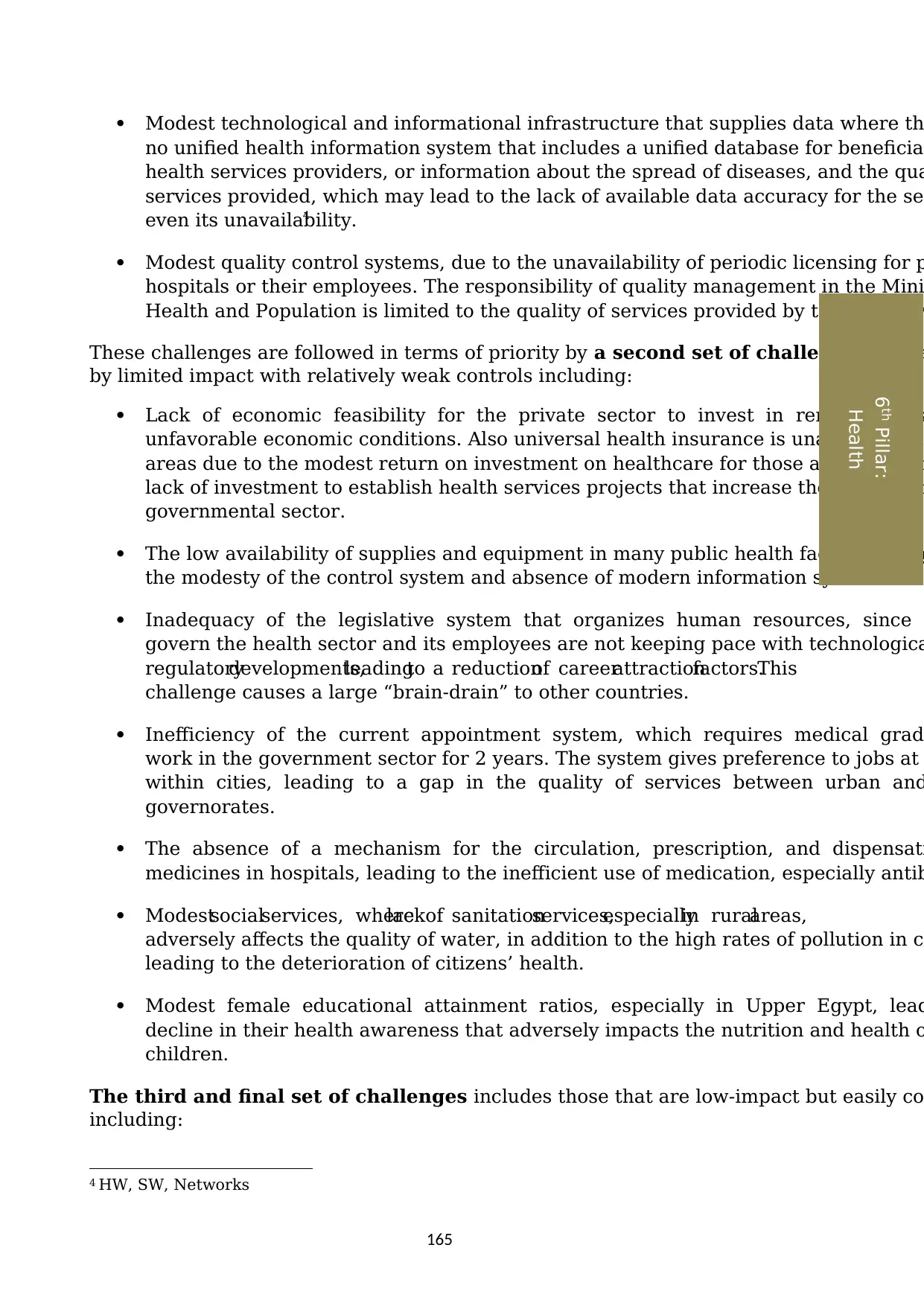
165
Modest technological and informational infrastructure that supplies data where th
no unified health information system that includes a unified database for beneficia
health services providers, or information about the spread of diseases, and the qua
services provided, which may lead to the lack of available data accuracy for the se
even its unavailability.4
Modest quality control systems, due to the unavailability of periodic licensing for p
hospitals or their employees. The responsibility of quality management in the Mini
Health and Population is limited to the quality of services provided by the Ministry
These challenges are followed in terms of priority by a second set of challenges chara
by limited impact with relatively weak controls including:
Lack of economic feasibility for the private sector to invest in remote areas
unfavorable economic conditions. Also universal health insurance is unavailable in
areas due to the modest return on investment on healthcare for those areas, leadin
lack of investment to establish health services projects that increase the burden on
governmental sector.
The low availability of supplies and equipment in many public health facilities in lig
the modesty of the control system and absence of modern information systems.
Inadequacy of the legislative system that organizes human resources, since
govern the health sector and its employees are not keeping pace with technologica
regulatorydevelopments,leadingto a reductionof careerattractionfactors.This
challenge causes a large “brain-drain” to other countries.
Inefficiency of the current appointment system, which requires medical grad
work in the government sector for 2 years. The system gives preference to jobs at
within cities, leading to a gap in the quality of services between urban and
governorates.
The absence of a mechanism for the circulation, prescription, and dispensati
medicines in hospitals, leading to the inefficient use of medication, especially antib
Modestsocialservices, wherelackof sanitationservices,especiallyin ruralareas,
adversely affects the quality of water, in addition to the high rates of pollution in c
leading to the deterioration of citizens’ health.
Modest female educational attainment ratios, especially in Upper Egypt, lead
decline in their health awareness that adversely impacts the nutrition and health o
children.
The third and final set of challenges includes those that are low-impact but easily co
including:
4 HW, SW, Networks
6th Pillar:
Health
Modest technological and informational infrastructure that supplies data where th
no unified health information system that includes a unified database for beneficia
health services providers, or information about the spread of diseases, and the qua
services provided, which may lead to the lack of available data accuracy for the se
even its unavailability.4
Modest quality control systems, due to the unavailability of periodic licensing for p
hospitals or their employees. The responsibility of quality management in the Mini
Health and Population is limited to the quality of services provided by the Ministry
These challenges are followed in terms of priority by a second set of challenges chara
by limited impact with relatively weak controls including:
Lack of economic feasibility for the private sector to invest in remote areas
unfavorable economic conditions. Also universal health insurance is unavailable in
areas due to the modest return on investment on healthcare for those areas, leadin
lack of investment to establish health services projects that increase the burden on
governmental sector.
The low availability of supplies and equipment in many public health facilities in lig
the modesty of the control system and absence of modern information systems.
Inadequacy of the legislative system that organizes human resources, since
govern the health sector and its employees are not keeping pace with technologica
regulatorydevelopments,leadingto a reductionof careerattractionfactors.This
challenge causes a large “brain-drain” to other countries.
Inefficiency of the current appointment system, which requires medical grad
work in the government sector for 2 years. The system gives preference to jobs at
within cities, leading to a gap in the quality of services between urban and
governorates.
The absence of a mechanism for the circulation, prescription, and dispensati
medicines in hospitals, leading to the inefficient use of medication, especially antib
Modestsocialservices, wherelackof sanitationservices,especiallyin ruralareas,
adversely affects the quality of water, in addition to the high rates of pollution in c
leading to the deterioration of citizens’ health.
Modest female educational attainment ratios, especially in Upper Egypt, lead
decline in their health awareness that adversely impacts the nutrition and health o
children.
The third and final set of challenges includes those that are low-impact but easily co
including:
4 HW, SW, Networks
6th Pillar:
Health
⊘ This is a preview!⊘
Do you want full access?
Subscribe today to unlock all pages.

Trusted by 1+ million students worldwide

166
The absence of a nursing culture in Upper Egypt. It is hard for Upper Egyptia
to accept their daughters working in the field of nursing, leading to a lack of q
medical teams in many health units and hospitals in Upper Egypt.
Mismatch of skills between higher education graduates and the needs of the h
where there is no certified mechanism for coordination between the needs and
graduates available to fill positions in required specialties.
High rates of unemployment among young people lead to increased rates of sm
drug abuse, which threaten public health and community peace, and adversel
national economy.
Failure to enforce the law banning the sale of cigarettes to young people unde
18 years and non-punishment of the offender, where the failure to enforce suc
addition to the drug abuse laws, leads to the prevalence of smoking an
among younger people.
The lack of an independent body for accreditation, regulation, and cont
services adversely affects the level and quality of such services, and cit
general.
Health Programs to 2030
In light of the challenges facing the health sector, which limit the achievement of its
Strategic Objectives, as well as the National Sustainable Development Objectives be
the State decided that its first priority in the coming period will be to enhan
healthcare services through the development of periodic and compulsory licensing f
facilities.
The State also aims at creating a mechanism for healthcare facility accreditation to
competition between different service providers in order to enhance the quality of s
attain generally accepted international standards. The State will also adopt th
continuing medical education as a prerequisite for the renewal of professional pract
for medical professionals.
In addition to these efforts and to enhance and support the policies, program
related to health development included into the government’s work program for 201
present the following top programs that have been selected for implementatio
great positive impact:
Application of universal health coverage
Program Description: This program aims to implement universal healt
including health services at all levels across the state, and universal he
coverage of citizens, especially underprivileged groups. This program is one o
cost programs and is expected to start its implementation in 2016 and to be c
by 2030.
The absence of a nursing culture in Upper Egypt. It is hard for Upper Egyptia
to accept their daughters working in the field of nursing, leading to a lack of q
medical teams in many health units and hospitals in Upper Egypt.
Mismatch of skills between higher education graduates and the needs of the h
where there is no certified mechanism for coordination between the needs and
graduates available to fill positions in required specialties.
High rates of unemployment among young people lead to increased rates of sm
drug abuse, which threaten public health and community peace, and adversel
national economy.
Failure to enforce the law banning the sale of cigarettes to young people unde
18 years and non-punishment of the offender, where the failure to enforce suc
addition to the drug abuse laws, leads to the prevalence of smoking an
among younger people.
The lack of an independent body for accreditation, regulation, and cont
services adversely affects the level and quality of such services, and cit
general.
Health Programs to 2030
In light of the challenges facing the health sector, which limit the achievement of its
Strategic Objectives, as well as the National Sustainable Development Objectives be
the State decided that its first priority in the coming period will be to enhan
healthcare services through the development of periodic and compulsory licensing f
facilities.
The State also aims at creating a mechanism for healthcare facility accreditation to
competition between different service providers in order to enhance the quality of s
attain generally accepted international standards. The State will also adopt th
continuing medical education as a prerequisite for the renewal of professional pract
for medical professionals.
In addition to these efforts and to enhance and support the policies, program
related to health development included into the government’s work program for 201
present the following top programs that have been selected for implementatio
great positive impact:
Application of universal health coverage
Program Description: This program aims to implement universal healt
including health services at all levels across the state, and universal he
coverage of citizens, especially underprivileged groups. This program is one o
cost programs and is expected to start its implementation in 2016 and to be c
by 2030.
Paraphrase This Document
Need a fresh take? Get an instant paraphrase of this document with our AI Paraphraser
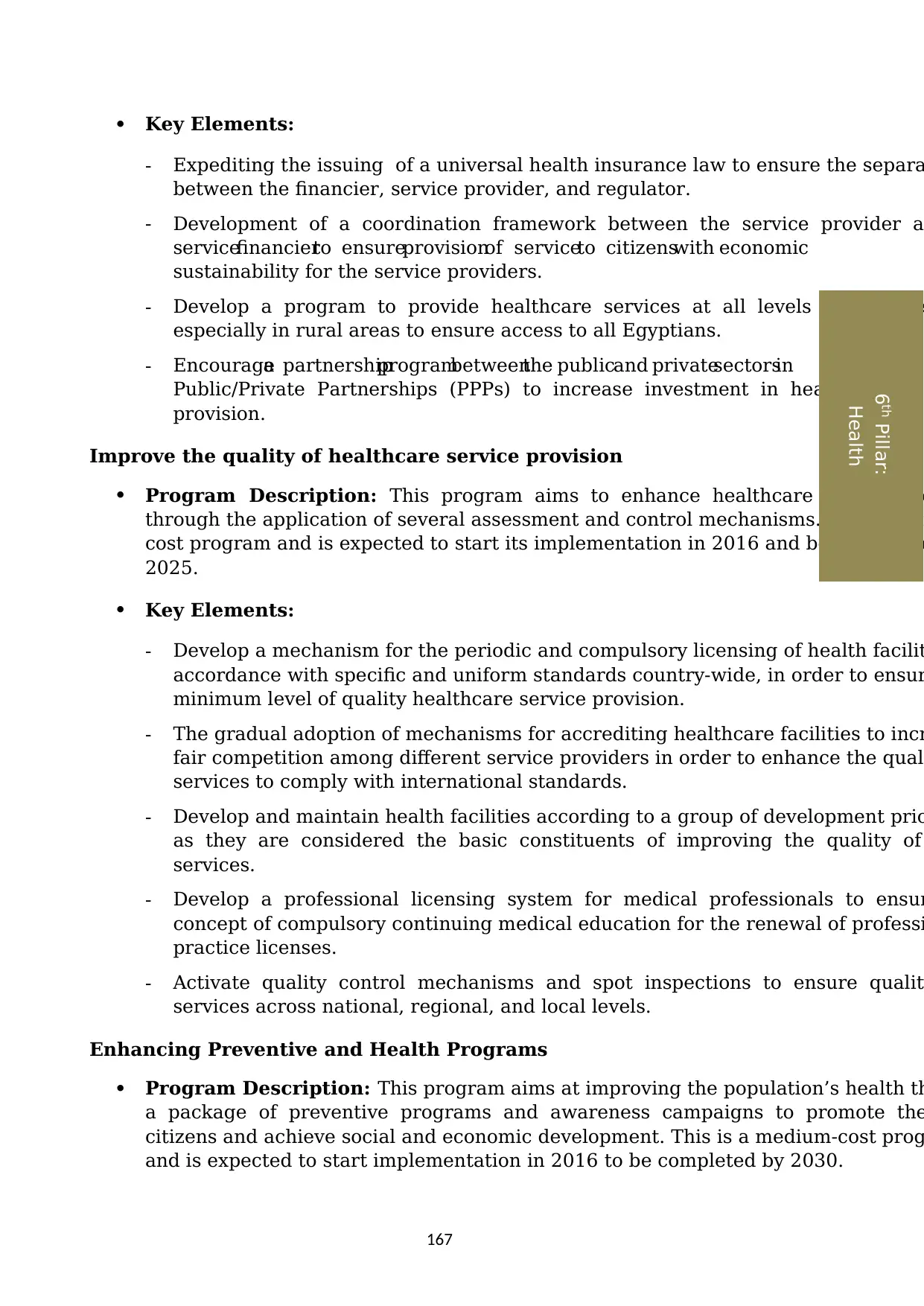
167
Key Elements:
- Expediting the issuing of a universal health insurance law to ensure the separa
between the financier, service provider, and regulator.
- Development of a coordination framework between the service provider a
servicefinancierto ensureprovisionof serviceto citizenswith economic
sustainability for the service providers.
- Develop a program to provide healthcare services at all levels across the
especially in rural areas to ensure access to all Egyptians.
- Encouragea partnershipprogrambetweenthe publicand privatesectorsin
Public/Private Partnerships (PPPs) to increase investment in healthcare se
provision.
Improve the quality of healthcare service provision
Program Description: This program aims to enhance healthcare services p
through the application of several assessment and control mechanisms. This is a hi
cost program and is expected to start its implementation in 2016 and be completed
2025.
Key Elements:
- Develop a mechanism for the periodic and compulsory licensing of health facilit
accordance with specific and uniform standards country-wide, in order to ensur
minimum level of quality healthcare service provision.
- The gradual adoption of mechanisms for accrediting healthcare facilities to incr
fair competition among different service providers in order to enhance the qual
services to comply with international standards.
- Develop and maintain health facilities according to a group of development prio
as they are considered the basic constituents of improving the quality of
services.
- Develop a professional licensing system for medical professionals to ensur
concept of compulsory continuing medical education for the renewal of professi
practice licenses.
- Activate quality control mechanisms and spot inspections to ensure qualit
services across national, regional, and local levels.
Enhancing Preventive and Health Programs
Program Description: This program aims at improving the population’s health th
a package of preventive programs and awareness campaigns to promote the
citizens and achieve social and economic development. This is a medium-cost prog
and is expected to start implementation in 2016 to be completed by 2030.
6th Pillar:
Health
Key Elements:
- Expediting the issuing of a universal health insurance law to ensure the separa
between the financier, service provider, and regulator.
- Development of a coordination framework between the service provider a
servicefinancierto ensureprovisionof serviceto citizenswith economic
sustainability for the service providers.
- Develop a program to provide healthcare services at all levels across the
especially in rural areas to ensure access to all Egyptians.
- Encouragea partnershipprogrambetweenthe publicand privatesectorsin
Public/Private Partnerships (PPPs) to increase investment in healthcare se
provision.
Improve the quality of healthcare service provision
Program Description: This program aims to enhance healthcare services p
through the application of several assessment and control mechanisms. This is a hi
cost program and is expected to start its implementation in 2016 and be completed
2025.
Key Elements:
- Develop a mechanism for the periodic and compulsory licensing of health facilit
accordance with specific and uniform standards country-wide, in order to ensur
minimum level of quality healthcare service provision.
- The gradual adoption of mechanisms for accrediting healthcare facilities to incr
fair competition among different service providers in order to enhance the qual
services to comply with international standards.
- Develop and maintain health facilities according to a group of development prio
as they are considered the basic constituents of improving the quality of
services.
- Develop a professional licensing system for medical professionals to ensur
concept of compulsory continuing medical education for the renewal of professi
practice licenses.
- Activate quality control mechanisms and spot inspections to ensure qualit
services across national, regional, and local levels.
Enhancing Preventive and Health Programs
Program Description: This program aims at improving the population’s health th
a package of preventive programs and awareness campaigns to promote the
citizens and achieve social and economic development. This is a medium-cost prog
and is expected to start implementation in 2016 to be completed by 2030.
6th Pillar:
Health
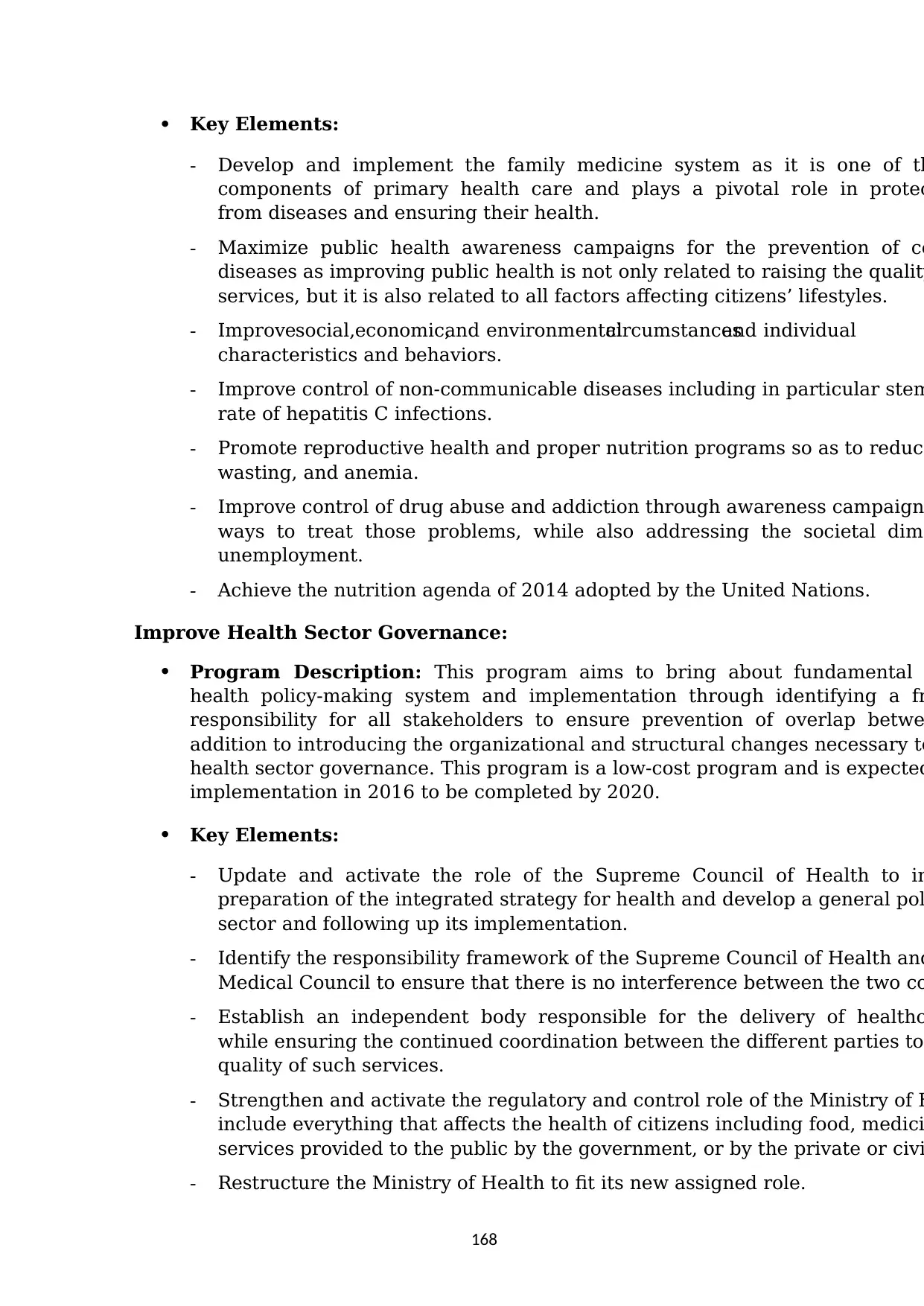
168
Key Elements:
- Develop and implement the family medicine system as it is one of th
components of primary health care and plays a pivotal role in protec
from diseases and ensuring their health.
- Maximize public health awareness campaigns for the prevention of co
diseases as improving public health is not only related to raising the quality
services, but it is also related to all factors affecting citizens’ lifestyles.
- Improvesocial,economic,and environmentalcircumstancesand individual
characteristics and behaviors.
- Improve control of non-communicable diseases including in particular stem
rate of hepatitis C infections.
- Promote reproductive health and proper nutrition programs so as to reduce
wasting, and anemia.
- Improve control of drug abuse and addiction through awareness campaign
ways to treat those problems, while also addressing the societal dime
unemployment.
- Achieve the nutrition agenda of 2014 adopted by the United Nations.
Improve Health Sector Governance:
Program Description: This program aims to bring about fundamental
health policy-making system and implementation through identifying a fr
responsibility for all stakeholders to ensure prevention of overlap betwe
addition to introducing the organizational and structural changes necessary to
health sector governance. This program is a low-cost program and is expected
implementation in 2016 to be completed by 2020.
Key Elements:
- Update and activate the role of the Supreme Council of Health to in
preparation of the integrated strategy for health and develop a general pol
sector and following up its implementation.
- Identify the responsibility framework of the Supreme Council of Health and
Medical Council to ensure that there is no interference between the two co
- Establish an independent body responsible for the delivery of healthc
while ensuring the continued coordination between the different parties to
quality of such services.
- Strengthen and activate the regulatory and control role of the Ministry of H
include everything that affects the health of citizens including food, medici
services provided to the public by the government, or by the private or civi
- Restructure the Ministry of Health to fit its new assigned role.
Key Elements:
- Develop and implement the family medicine system as it is one of th
components of primary health care and plays a pivotal role in protec
from diseases and ensuring their health.
- Maximize public health awareness campaigns for the prevention of co
diseases as improving public health is not only related to raising the quality
services, but it is also related to all factors affecting citizens’ lifestyles.
- Improvesocial,economic,and environmentalcircumstancesand individual
characteristics and behaviors.
- Improve control of non-communicable diseases including in particular stem
rate of hepatitis C infections.
- Promote reproductive health and proper nutrition programs so as to reduce
wasting, and anemia.
- Improve control of drug abuse and addiction through awareness campaign
ways to treat those problems, while also addressing the societal dime
unemployment.
- Achieve the nutrition agenda of 2014 adopted by the United Nations.
Improve Health Sector Governance:
Program Description: This program aims to bring about fundamental
health policy-making system and implementation through identifying a fr
responsibility for all stakeholders to ensure prevention of overlap betwe
addition to introducing the organizational and structural changes necessary to
health sector governance. This program is a low-cost program and is expected
implementation in 2016 to be completed by 2020.
Key Elements:
- Update and activate the role of the Supreme Council of Health to in
preparation of the integrated strategy for health and develop a general pol
sector and following up its implementation.
- Identify the responsibility framework of the Supreme Council of Health and
Medical Council to ensure that there is no interference between the two co
- Establish an independent body responsible for the delivery of healthc
while ensuring the continued coordination between the different parties to
quality of such services.
- Strengthen and activate the regulatory and control role of the Ministry of H
include everything that affects the health of citizens including food, medici
services provided to the public by the government, or by the private or civi
- Restructure the Ministry of Health to fit its new assigned role.
⊘ This is a preview!⊘
Do you want full access?
Subscribe today to unlock all pages.

Trusted by 1+ million students worldwide
1 out of 14
Related Documents
Your All-in-One AI-Powered Toolkit for Academic Success.
+13062052269
info@desklib.com
Available 24*7 on WhatsApp / Email
![[object Object]](/_next/static/media/star-bottom.7253800d.svg)
Unlock your academic potential
Copyright © 2020–2025 A2Z Services. All Rights Reserved. Developed and managed by ZUCOL.





